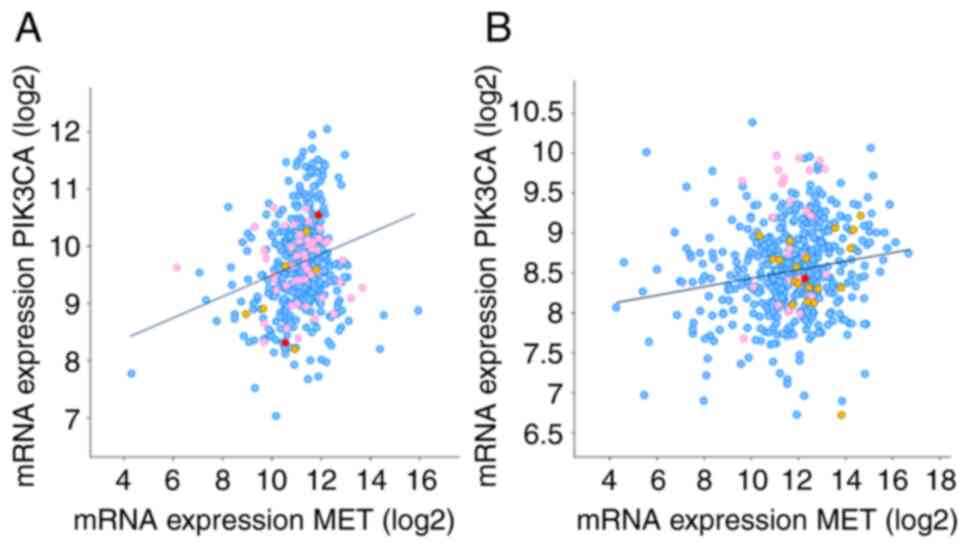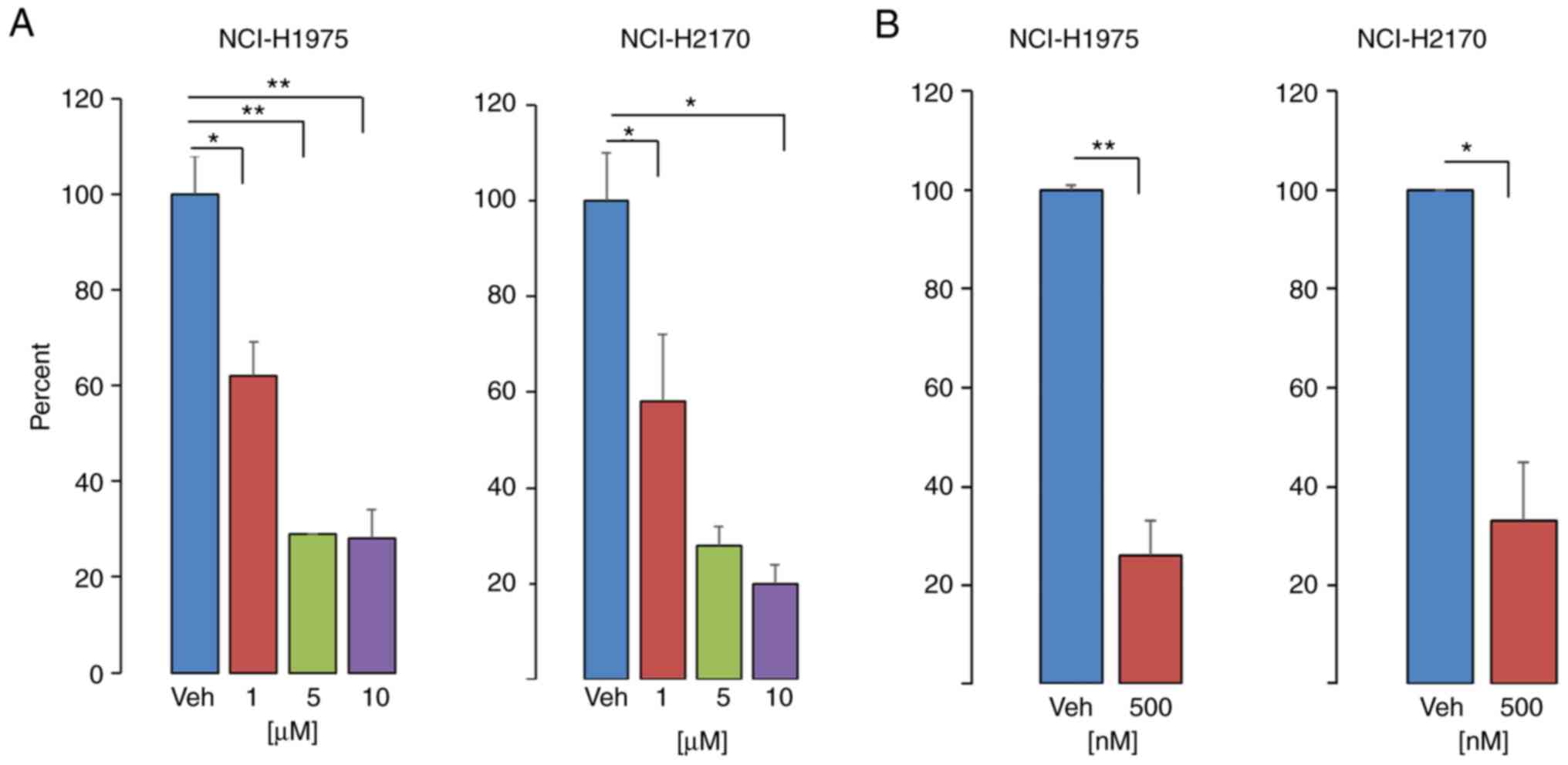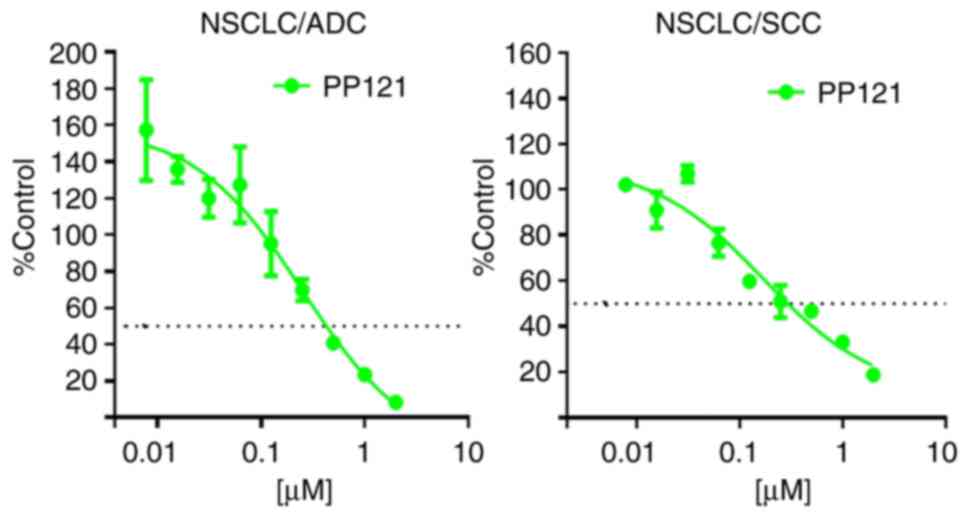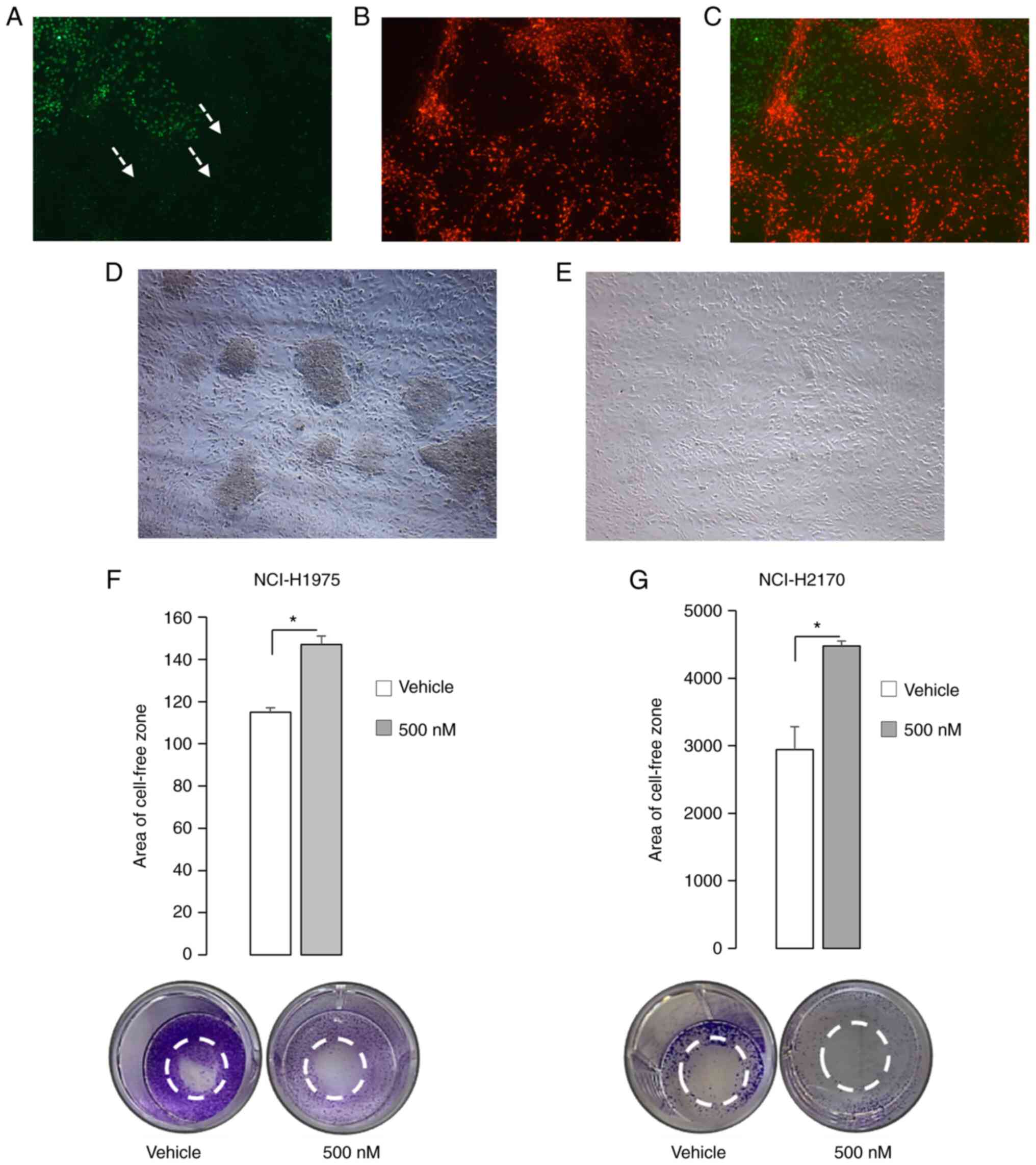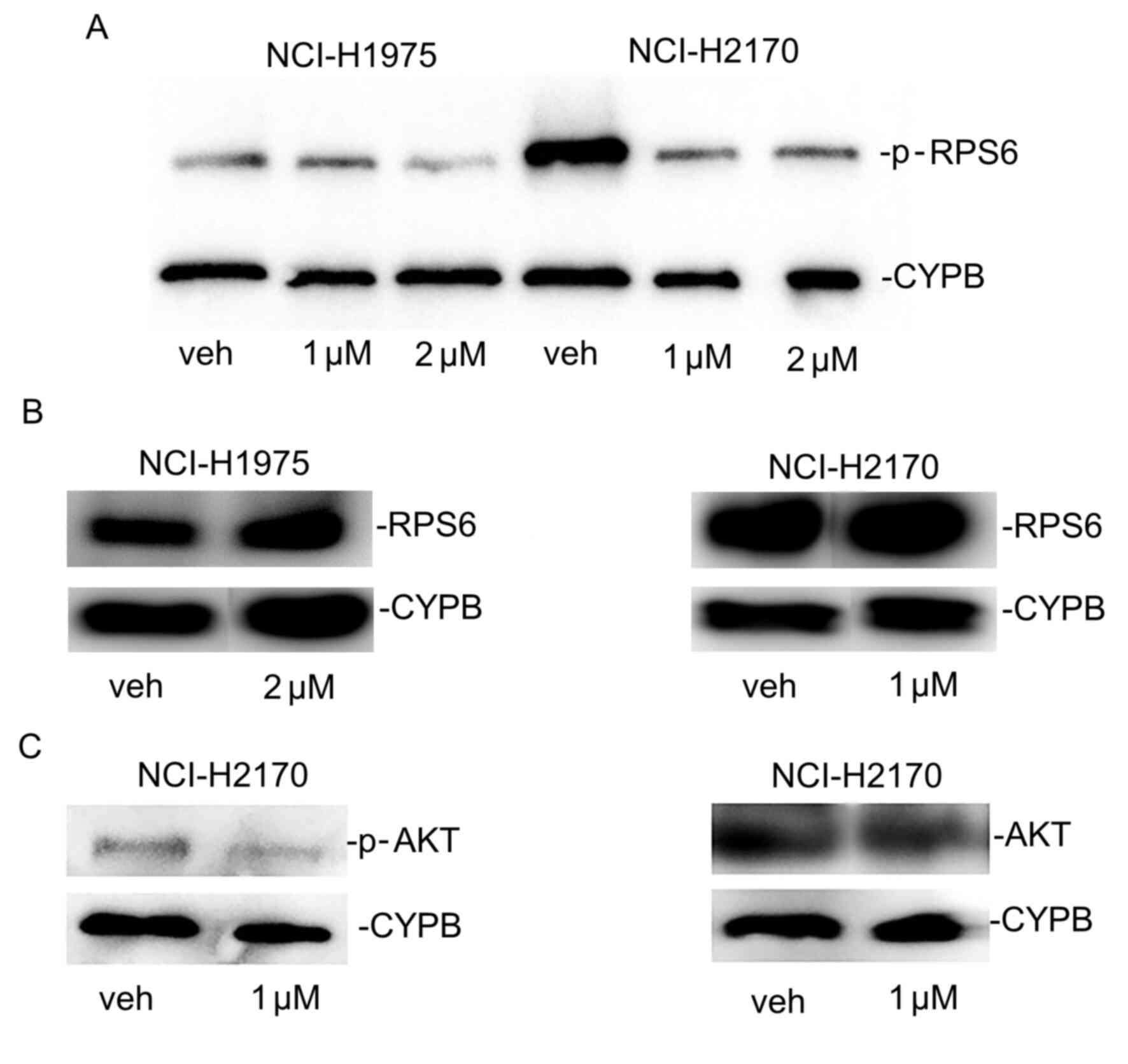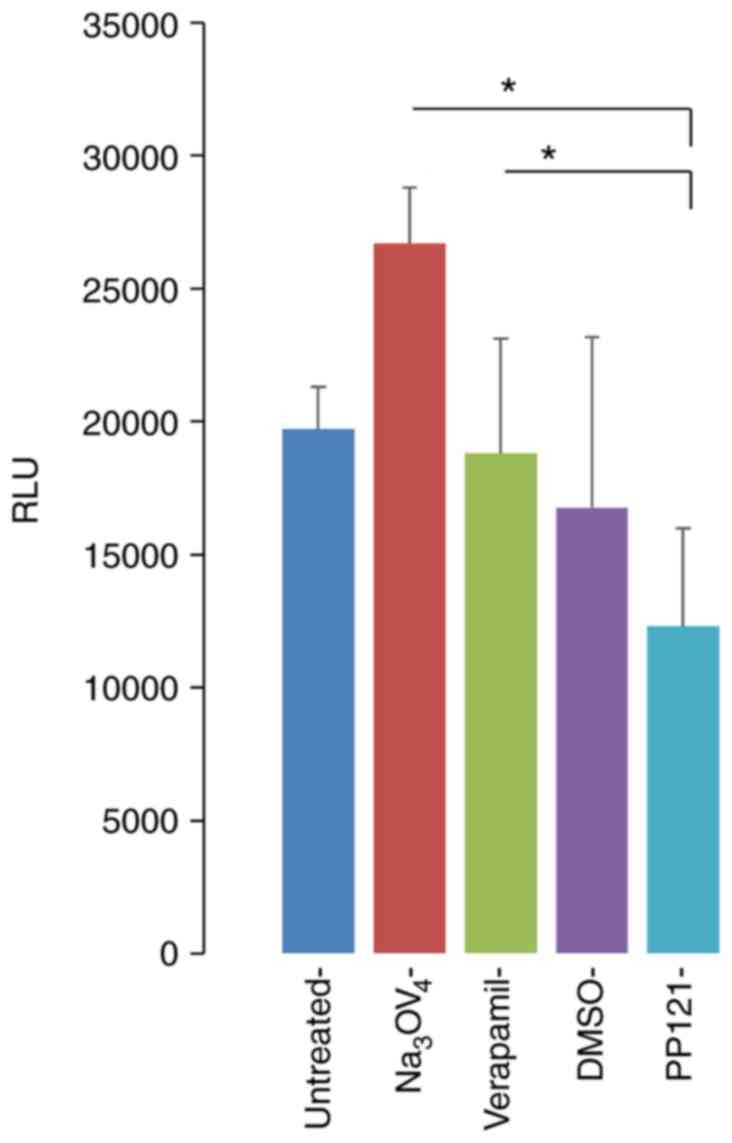|
1
|
Siegel R, Naishadham D and Jemal A: Cancer
statistics, 2012. CA Cancer J Clin. 62:10–29. 2012.PubMed/NCBI View Article : Google Scholar
|
|
2
|
Siegel R, Naishadham D and Jemal A: Cancer
statistics, 2013. CA Cancer J Clin. 63:11–30. 2013.PubMed/NCBI View Article : Google Scholar
|
|
3
|
Yuan M, Huang LL, Chen JH, Wu J and Xu Q:
The emerging treatment landscape of targeted therapy in
non-small-cell lung cancer. Sig Transduct Target Ther.
4(61)2019.PubMed/NCBI View Article : Google Scholar
|
|
4
|
König D, Savic Prince S and Rothschild SI:
Targeted therapy in advanced and metastatic non-small cell lung
cancer. An update on treatment of the most important actionable
oncogenic driver alterations. Cancers (Basel).
13(804)2021.PubMed/NCBI View Article : Google Scholar
|
|
5
|
Gazdar AF: Activating and resistance
mutations of EGFR in non-small-cell lung cancer: Role in clinical
response to EGFR tyrosine kinase inhibitors. Oncogene. 28 (Suppl
1):S24–S31. 2009.PubMed/NCBI View Article : Google Scholar
|
|
6
|
Clark J, Cools J and Gilliland DG: EGFR
inhibition in non-small cell lung cancer: Resistance, once again,
rears its ugly head. PLoS Med. 2(e75)2005.PubMed/NCBI View Article : Google Scholar
|
|
7
|
Suda K, Murakami I, Katayama T, Tomizawa
K, Osada H, Sekido Y, Maehara Y, Yatabe Y and Mitsudomi T:
Reciprocal and complementary role of MET amplification and EGFR
T790M mutation in acquired resistance to kinase inhibitors in lung
cancer. Clin Cancer Res. 16:5489–5498. 2010.PubMed/NCBI View Article : Google Scholar
|
|
8
|
Li F, Zhu T, Cao B, Wang J and Liang L:
Apatinib enhances antitumour activity of EGFR-TKIs in non-small
cell lung cancer with EGFR-TKI resistance. Eur J Cancer.
84:184–192. 2017.PubMed/NCBI View Article : Google Scholar
|
|
9
|
Zhang Z, Zhang Y, Luo F, Ma Y, Fang W,
Zhan J, Li S, Yang Y, Zhao Y, Hong S, et al: Dual blockade of EGFR
and VEGFR pathways: Results from a pilot study evaluating apatinib
plus gefitinib as a first-line treatment for advanced EGFR-mutant
non-small cell lung cancer. Clin Transl Med. 10(e33)2020.PubMed/NCBI View
Article : Google Scholar
|
|
10
|
Benedettini E, Sholl LM, Peyton M, Reilly
J, Ware C, Davis L, Vena N, Bailey D, Yeap BY, Fiorentino M, et al:
Met activation in non-small cell lung cancer is associated with de
novo resistance to EGFR inhibitors and the development of brain
metastasis. Am J Pathol. 177:415–423. 2010.PubMed/NCBI View Article : Google Scholar
|
|
11
|
Preusser M, Streubel B, Berghoff AS,
Hainfellner JA, von Deimling A, Widhalm G, Dieckmann K, Wöhrer A,
Hackl M, Zielinski C and Birner P: Amplification and overexpression
of CMET is a common event in brain metastases of non-small cell
lung cancer. Histopathology. 65:684–692. 2014.PubMed/NCBI View Article : Google Scholar
|
|
12
|
Breindel JL, Haskins JW, Cowell EP, Zhao
M, Nguyen DX and Stern DF: EGF receptor activates MET through MAPK
to enhance non-small cell lung carcinoma invasion and brain
metastasis. Cancer Res. 73:5053–5065. 2013.PubMed/NCBI View Article : Google Scholar
|
|
13
|
Peng Y, Zhou Y, Cheng L, Hu D, Zhou X,
Wang Z, Xie C and Zhou F: The anti-esophageal cancer cell activity
by a novel tyrosine/phosphoinositide kinase inhibitor PP121.
Biochem Biophys Res Commun. 465:137–144. 2015.PubMed/NCBI View Article : Google Scholar
|
|
14
|
Apsel B, Blair JA, Gonzalez B, Nazif TM,
Feldman ME, Aizenstein B, Hoffman R, Williams RL, Shokat KM and
Knight ZA: Targeted polypharmacology: Discovery of dual inhibitors
of tyrosine and phosphoinositide kinases. Nat Chem Biol. 4:691–699.
2008.PubMed/NCBI View Article : Google Scholar
|
|
15
|
Che HY, Guo HY, Si XW, You QY and Lou WY:
PP121, a dual inhibitor of tyrosine and phosphoinositide kinases,
inhibits anaplastic thyroid carcinoma cell proliferation and
migration. Tumour Biol. 35:8659–8664. 2014.PubMed/NCBI View Article : Google Scholar
|
|
16
|
Kenny HA, Lal-Nag M, Shen M, Kara B,
Nahotko DA, Wroblewski K, Fazal S, Chen S, Chiang CY, Chen YJ, et
al: Quantitative high-throughput screening using an organotypic
model identifies compounds that inhibit ovarian cancer metastasis.
Mol Cancer Ther. 19:52–62. 2020.PubMed/NCBI View Article : Google Scholar
|
|
17
|
Moore G, Lightner C, Elbai S, Brady L,
Nicholson S, Ryan R, O'Sullivan KE, O'Byrne KJ, Blanco-Aparicio C,
Cuffe S, et al: Co-Targeting PIM Kinase and PI3K/mTOR in NSCLC.
Cancers (Basel). 13(2139)2021.PubMed/NCBI View Article : Google Scholar
|
|
18
|
Montaudon E, El Botty R, Vacher S, Déas O,
Naguez A, Chateau-Joubert S, Treguer D, de Plater L, Zemoura L,
Némati F, et al: High in vitro and in vivo synergistic activity
between mTORC1 and PLK1 inhibition in adenocarcinoma NSCLC.
Oncotarget. 12:859–872. 2021.PubMed/NCBI View Article : Google Scholar
|
|
19
|
Han J, Liu Y, Yang S, Wu X, Li H and Wang
Q: MEK inhibitors for the treatment of non-small cell lung cancer.
J Hematol Oncol. 14(1)2021.PubMed/NCBI View Article : Google Scholar
|
|
20
|
Pérez-Tomás R: Multidrug resistance:
Retrospect and prospects in anti-cancer drug treatment. Curr Med
Chem. 13:1859–1876. 2006.PubMed/NCBI View Article : Google Scholar
|
|
21
|
Chen KG, Valencia JC, Gillet JP, Hearing
VJ and Gottesman MM: Involvement of ABC transporters in
melanogenesis and the development of multidrug resistance of
melanoma. Pigment Cell Melanoma Res. 22:740–749. 2009.PubMed/NCBI View Article : Google Scholar
|
|
22
|
Chai AB, Callaghan R and Gelissen IC:
Regulation of P-Glycoprotein in the Brain. Int J Mol Sci.
23(14667)2022.PubMed/NCBI View Article : Google Scholar
|
|
23
|
Haar CP, Hebbar P, Wallace GC IV, Das A,
Vandergrift WA III, Smith JA, Giglio P, Patel SJ, Ray SK and Banik
NL: Drug resistance in glioblastoma: A mini review. Neurochem Res.
37:1192–1200. 2012.PubMed/NCBI View Article : Google Scholar
|
|
24
|
Bean J, Brennan C, Shih JY, Riely G, Viale
A, Wang L, Chitale D, Motoi N, Szoke J, Broderick S, et al: MET
amplification occurs with or without T790M mutations in EGFR mutant
lung tumors with acquired resistance to gefitinib or erlotinib.
Proc Natl Acad Sci USA. 104:20932–20937. 2007.PubMed/NCBI View Article : Google Scholar
|
|
25
|
Han B, Li K, Wang Q, Zhang L, Shi J, Wang
Z, Cheng Y, He J, Shi Y, Zhao Y, et al: Effect of anlotinib as a
third-line or further treatment on overall survival of patients
with advanced non-small cell lung cancer: The ALTER 0303 phase 3
randomized clinical trial. JAMA Oncol. 4:1569–1575. 2018.PubMed/NCBI View Article : Google Scholar
|
|
26
|
Zhang M, Quan H, Fu L, Li Y, Fu H and Lou
L: Third-generation EGFR inhibitor HS-10296 in combination with
famitinib, a multi-targeted tyrosine kinase inhibitor, exerts
synergistic antitumor effects through enhanced inhibition of
downstream signaling in EGFR-mutant non-small cell lung cancer
cells. Thorac Cancer. 12:1210–1218. 2021.PubMed/NCBI View Article : Google Scholar
|
|
27
|
Sun YW, Xu J, Zhou J and Liu WJ: Targeted
drugs for systemic therapy of lung cancer with brain metastases.
Oncotarget. 9:5459–5472. 2017.PubMed/NCBI View Article : Google Scholar
|
|
28
|
Dai W, Zhu H, Chen G, Gu H, Gu Y, Sun X
and Zeng X: Orchestration of the crosstalk between astrocytes and
cancer cells affects the treatment and prognosis of lung cancer
sufferers with brain metastasis. J Thorac Dis. 8:E1450–E1454.
2016.PubMed/NCBI View Article : Google Scholar
|
|
29
|
Lin J, Jandial R, Nesbit A, Badie B and
Chen M: Current and emerging treatments for brain metastases.
Oncology (Williston Park). 29:250–257. 2015.PubMed/NCBI
|
|
30
|
Ni W, Chen W and Lu Y: Emerging findings
into molecular mechanism of brain metastasis. Cancer Med.
7:3820–3833. 2018.PubMed/NCBI View Article : Google Scholar
|
|
31
|
Hanibuchi M, Kim SJ, Fidler IJ and
Nishioka Y: The molecular biology of lung cancer brain metastasis:
An overview of current comprehensions and future perspectives. J
Med Invest. 61:241–253. 2014.PubMed/NCBI View Article : Google Scholar
|















